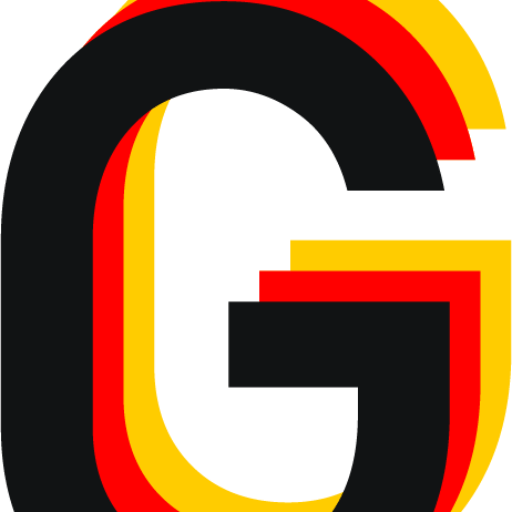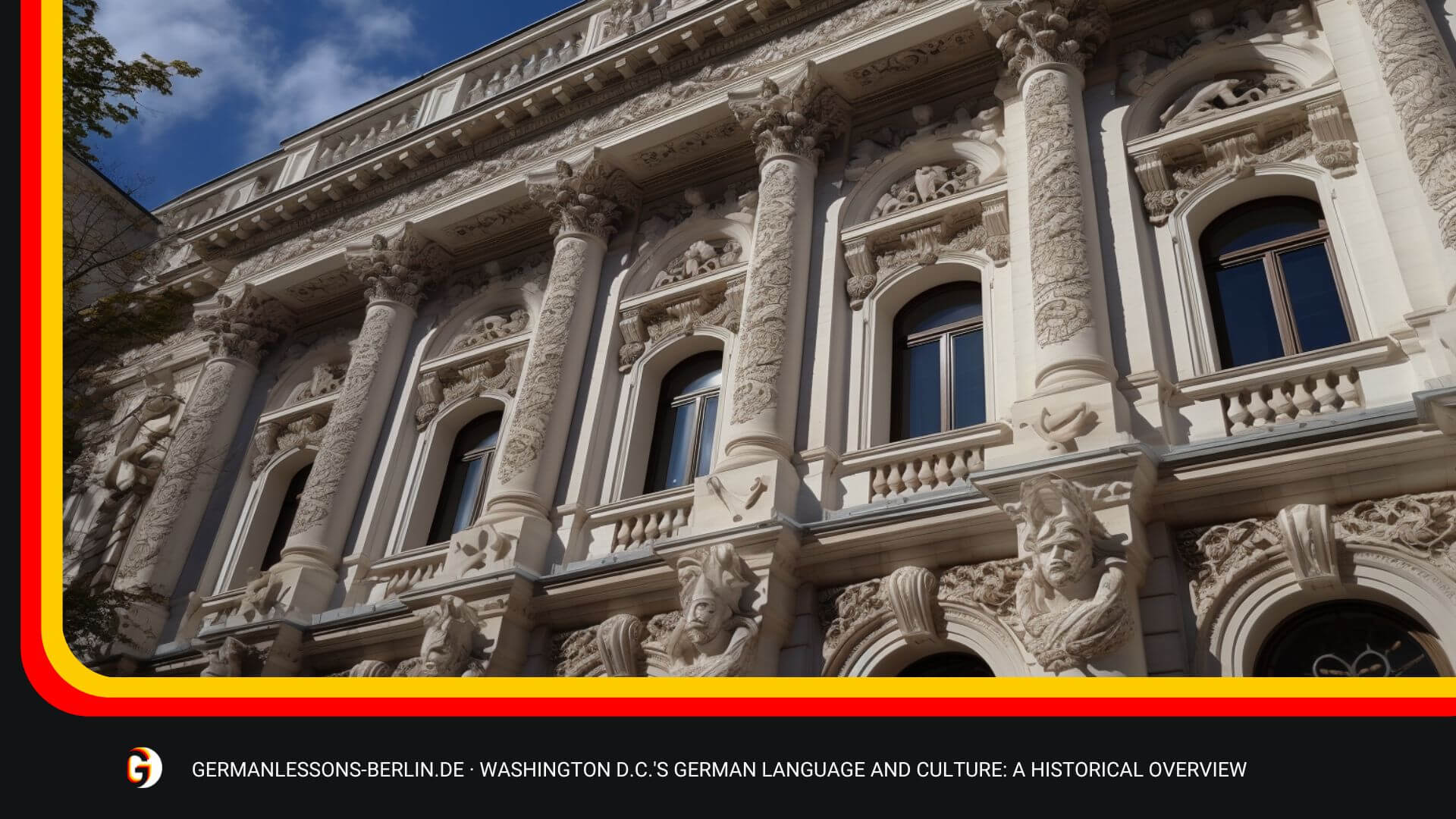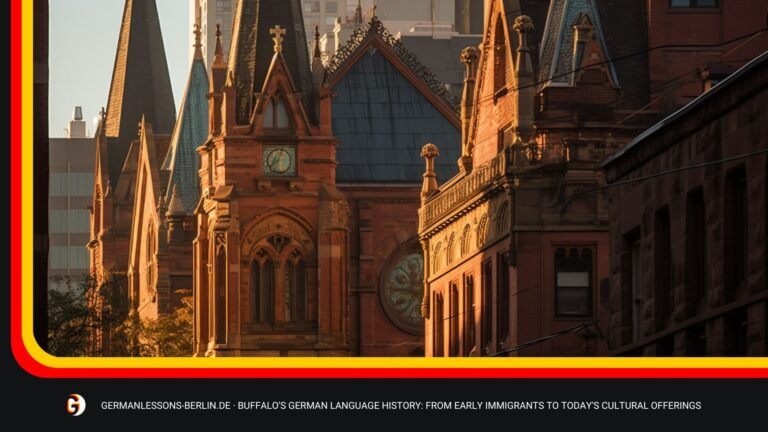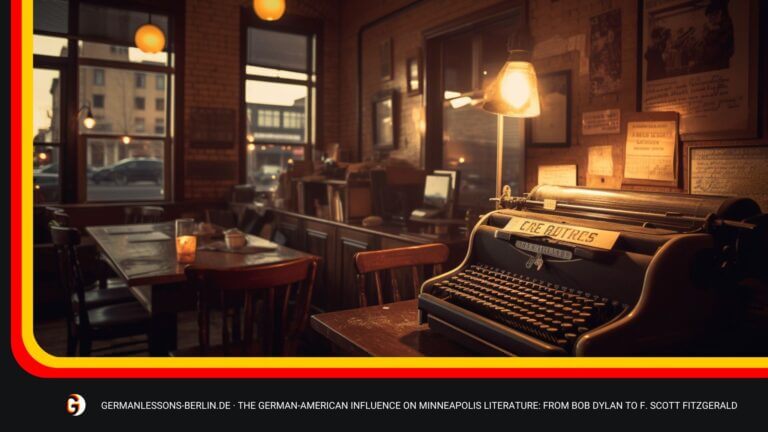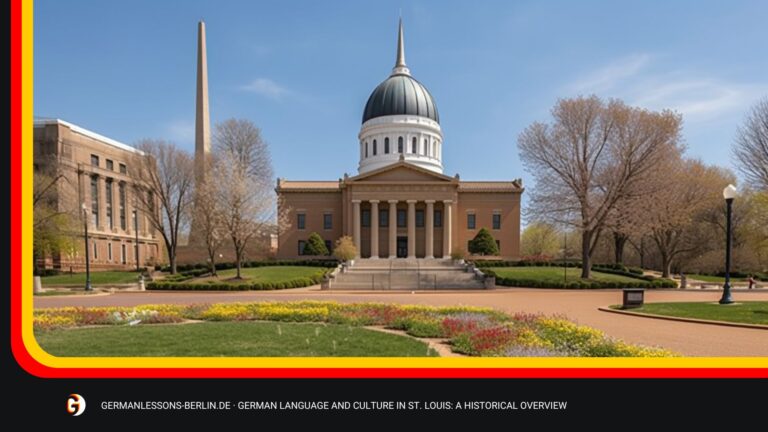Washington, D.C.’s German language and culture have a long, rich history deeply rooted in the city’s identity and character. From its early beginnings as an area populated by mainly German immigrants to its current state as a vibrant hub of politics, business, and culture with strong ties to Germany, it is no wonder why this capital city continues to be home to many who speak and live according to German traditions. This article will provide an overview of Washington, D.C.’s unique contribution to developing the German language and culture in America over time.
German-speaking immigrants had undoubtedly left their mark on Washington D.C., especially during the 19th century when large waves of Germans arrived from around Europe seeking new opportunities for themselves and their families in America. Then, Washington D.C.’s population grew significantly due to these newcomers bringing their language along with them – setting into motion what would become known as one of the most significant periods for the German language and culture in American history.
The influence of German language and culture extends beyond just immigration, though; within the city itself, there are numerous organizations dedicated to preserving, expanding, teaching, and celebrating all aspects of German language and heritage through events such as Oktoberfest celebrations, dance classes hosted at local libraries, film screenings showcasing works by renowned directors like Werner Herzog or Wim Wenders, performances put on by local theater groups performing plays written in either English or German scripts — to name a few examples! In short: there is something here for everyone interested in delving deeper into understanding how Washington D.C.’s relationship with Germany has evolved throughout history up until now!
Table of Contents
Early Immigration To Washington D.C.
German immigration to Washington D.C. can be traced back to the 19th century when many German-Americans moved into the area seeking work and opportunity. During this period, thousands of Germans left their homeland searching for a better life in America; many of these immigrants settled in Washington, D.C., where they established communities and developed a strong culture rooted in language and tradition.
One such community was centered around the city’s Seventh Street corridor, which had become known as “Little Germany” by the late 1800s due to its high concentration of German immigrants. Here, German newspapers were published, businesses opened up catering to German customers, and churches with services held entirely in German flourished; indeed, it seemed that an entire world within Washington D.C.’s borders had been created just for these new arrivals from across the Atlantic ocean.
The impact of early German immigration on Washington D.C.’s cultural landscape remains evident today. Numerous monuments and memorials are dedicated to those who made the capital what it is now, reminders of our past that will undoubtedly continue inspiring generations for years to come.
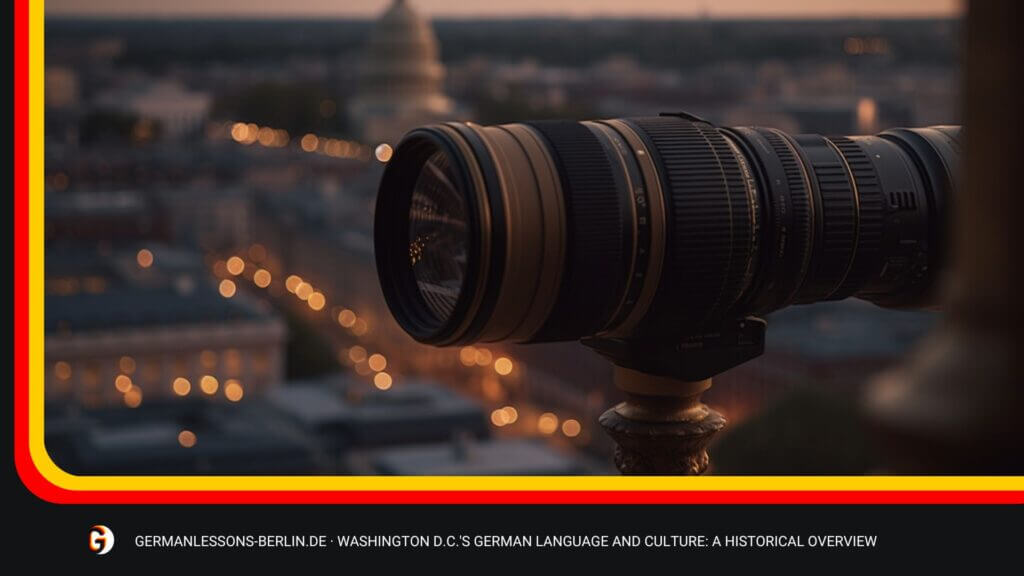
Development Of German Language Schools
With the wave of German immigration to Washington D.C., the city saw an increased need for German language education and learning opportunities, particularly in schools. Several local groups developed programs and organizations dedicated to providing high-quality German language instruction to meet this demand. In 1896, a group led by Dr. Henry Siegel established the Beethoven Society to promote German culture through music classes and other activities.
In addition to such educational initiatives, various churches in Washington D.C. also began offering Sunday school classes that provided children with basic knowledge of their ancestral language. This was especially true at St. Mary’s Catholic Church on Capitol Hill, where priests taught young students from immigrant families how to read, write, and converse in their native tongue.
By 1910 there were more than twenty public and private schools across the city devoted exclusively to teaching German as a primary or secondary language to its students – sometimes even alongside English classes – including some which catered specifically to adults who wished to gain fluency in their mother tongue too. Ultimately these efforts helped create a strong foundation for multilingualism within Washington D.C.’s population while ensuring that future generations would remember their cultural heritage.
Organizations And Clubs
Washington, D.C., has had a long-standing history of German-American and German-speaking organizations, clubs, and societies that have been active in the region for centuries. The earliest records of such cultural associations date back to the late 18th century when members of what would become known as ‘The German Society’ formed in Washington City (as it was then called) in 1796. This society provided an essential focal point for expat Germans living in America’s capital.
In subsequent decades, more language and culture groups were founded, including several German-language newspapers operating during the 19th century like Der Deutsche Correspondent and Die Nationalzeitung, as well as other short-lived publications such as Der Freiheitsbote und Volksfreund which served to connect immigrant communities with news from their homeland. These papers also featured articles on local theater performances, music concerts, lectures, picnics, and social events hosted by local German societies or churches.
By the early 20th century, there were dozens of prominent organizations dedicated to promoting the German language and culture throughout the area, including the Washington Schillerbund, which focused on literary works; Gesang Verein Harmonie started in 1862, which held regular singing competitions; Turnvereinen devoted to physical education; several women’s clubs such as Frauenvereine Leipzig created in 1890; various veterans’ organizations like Deutscher Veteranen Bund’ Hermann von Berckheim’ established after World War I; youth groups associated with educational institutions aimed at teaching young children about their heritage like Jungdeutsche Schule Bethesda founded in 1910; even special interest groups focusing exclusively on specific aspects of Germany’s culture like Mädchenkriegerverein der deutschen Kulturgeschichte organized around 1915.
These organizations continue to exist today, providing essential outlets for anyone interested in connecting with fellow expats or learning more about Germany’s rich history through language classes, cultural activities, or exciting trips abroad—all while helping preserve tradition and create new memories along the way.
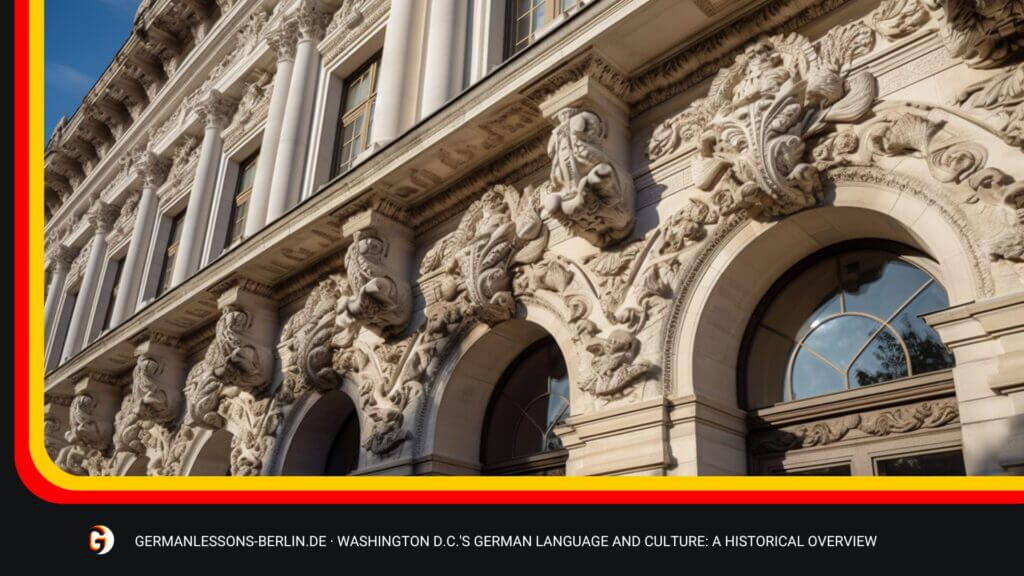
Celebrations And Festivals
Washington, D.C., is home to a wealthy German language and culture, with many traditional festivals and celebrations taking place throughout the year that honor its heritage. These events have been held since the city’s early days as a significant hub of German-American activity in America, giving residents and visitors alike a chance to experience some of Germany’s most beloved customs.
Washington, D.C.’s vibrant German community celebrates Maifest or May Festival each spring by gathering together for music, dancing, food, and fun activities. The festival typically takes place at one of the city’s popular outdoor venues, such as the National Mall or Dupont Circle Park, bringing out thousands of attendees who come dressed in their finest traditional costumes for an evening of celebration.
The fall season brings Oktoberfest to Washington, D.C., featuring Bavarian folk dances and performances from local musicians. At the same time, patrons enjoy authentic German cuisine, including bratwursts and pretzels washed down with plenty of beer! Additionally, during this time, various churches will host special services dedicated to celebrating Reformation Day, which honors Martin Luther’s 95 Theses published in 1517 that helped launch the Protestant Reformation movement across Europe:
- German Festivals: Maifest & Oktoberfest
- DC German Festivals: Celebrations Honoring Martin Luther on Reformation Day
- Washington DC Festivals: Music, Dancing & Authentic Cuisine
- DC Celebrations: Costumes & Fun Activities
Impact On The Local Cuisine
As the German-American population in Washington D.C. grew, so did their influence on the local cuisine. German gastronomy became interwoven with traditional American dishes through its restaurants and food culture to create a unique eating experience in the area. From sauerbraten and bratwurst to spätzle and strudel, many of these German-style dishes were served at different eateries around town – most notably at some of the city’s top-rated dining establishments.
The impact of this fusion cooking was felt beyond just taste; it also affected how people ate and socialized together. For instance, one popular restaurant specializing in German-influenced cuisine offered extraordinary “family style” seating where guests could share large platters of food while conversing with each other – a tradition typically found only in Germany. This is evidence of how deeply ingrained German food culture has become in Washington, D.C., creating a lasting legacy for future generations.
Over time, as more chefs embrace classic American recipes and those from Germany, we will continue to see new menu items created by combining these two distinct cuisines into something unique – adding even more variety to the thriving culinary scene here in Washington, D.C. It is clear that although much had changed since the early days when Germans first arrived here, they have left behind an indelible mark on this city through their love of food and sharing it with others – making sure that their traditions are never forgotten no matter how far away they may be from home!
Contributions To Literature And Music
Washington, D.C., a hub of culture and creativity, has been home to many German language contributors since the early 1800s. Throughout history, German literature, music, and language contributions have been integral to Washington’s cultural landscape.
The earliest known example of German literary contributions dates back to 1809 with a small pamphlet published by local printer John Binns titled “A Collection of Hymns for Public Worship,” which contained both English and German versions. This marked the first time German was used as a medium for religious expression in the area. In subsequent years, other forms of literature, such as books, pamphlets, and newspapers, were printed using only or mainly the German language. Many Germans who immigrated to this region brought along their native publications from Europe; some even went on to write works in their newly adopted homeland about life in America from a foreign perspective.
German musical contributions also started gaining traction around this period when musicians began incorporating traditional instruments like accordions into popular songs heard throughout the city streets during this era. Additionally, many composers wrote pieces designed for singing groups entirely of Germans living in Washington, D.C. As more immigrants moved into the region, they helped bring forth various styles of folk songwriting, which allowed them to express their beliefs through music while preserving part of Germany’s rich cultural heritage at the same time.
Today there is still evidence of these past literary and musical contributions, thanks mainly in part to organizations such as The Goethe-Institut Washington DC, which provides opportunities for locals interested in continuing these traditions within our community today. Through events such as concerts featuring classical works written by renowned European composers to public readings held at nearby libraries showcasing modern-day authors hailing from Berlin – it is clear that Washington D.C.’s connection with its rich Germanic roots remains strong even after all these years.
Influence On Architecture And Design
German culture in Washington D.C. has had a lasting impact on the capital’s architecture and design since its initial introduction during the 19th century. The city boasts several German-style buildings, monuments, and artworks that have become iconic landmarks for tourists and locals alike.
The presence of German immigrants to D.C., many of whom were artisans or skilled laborers, is reflected in numerous government structures throughout the District. One such example is the Old Post Office Pavilion, an extravagant structure near Pennsylvania Avenue designed by architect James G. Hill in 1888 after he visited Germany before construction. Other examples include Building Number 8 at Fort Myer (1891), the Smithsonian Castle (1855), and even some of the museums around town, like the Freer Gallery of Art (1923).
The German influence can also be seen in certain memorials dedicated to WWI veterans across various parks in Washington, D.C. These include sculptures made by Albert Jaegers—a sculptor who studied under Augustus Saint-Gaudens—and other artists with ties to Germany, as well as war monuments erected between 1924–25 which feature inscriptions written in both English and German to honor those who died fighting from both sides of the conflict. German contributions have been essential to creating much of what we see today when walking through our nation’s capital city.
Role In Politics And Government
German-Americans in Washington, D.C., have played an essential role in politics and government, especially throughout the twentieth century. From foreign policy to diplomatic relations, the influence of German culture and language has been pervasive and far-reaching. The following table provides a more detailed look at influential German-American politicians and their impact on U.S. government affairs:
| Politician | Political Influence | Government Influence |
|---|---|---|
| Theodore Roosevelt | Established foreign trade policies with Germany | Instrumental in strengthening ties between America & Germany during WWI by providing aid and supplies |
| John J. Pershing | Developed strategies for American forces in Europe during World War I | Oversaw negotiations that established lasting peace after WWI |
| George Marshall | Formulated economic plans to support post-war reconstruction efforts across Europe | Negotiated trade agreements with countries belonging to the European Union |
These three men are only a few examples of how German-Americans influenced politics and government in Washington, D.C. For example, Theodore Roosevelt’s work was essential in creating better diplomatic relations between the United States and Germany. At the same time, John J. Pershing helped ensure a peaceful resolution after WWI through his leadership as a general. Additionally, George Marshall had a significant hand in rebuilding Europe via his famous “Marshall Plan,” which provided financial assistance for those affected by war destruction, ultimately leading to improved U.S.-European relationships over time. In sum, these three individuals demonstrate how integral German culture has been to the success of our nation’s political systems—from international diplomacy to domestic governance solutions.
Preservation Of Heritage Today
Today, many German-Americans living in the Washington D.C. area have worked hard to preserve their heritage and language for future generations. The influence of its German immigrants has enriched the city’s vibrant culture, fondly remembered for their contributions to music, cuisine, and industry. There is a growing effort to promote language education and cultural exchange opportunities among local students and families to ensure these traditions remain alive.
The revival of German language classes offered at universities in the region makes it possible for people from all walks of life to learn more about this unique culture. This includes traditional programs and innovative initiatives such as online learning modules offering convenient access to resources worldwide. In addition, various organizations in Washington D.C., such as churches, clubs, and libraries, also serve as hubs for events relating to German history and culture – providing further avenues for cultural enrichment and dialogue among members of different backgrounds.
Preserving one’s heritage is integral to maintaining identity, especially when faced with constant change in our modern world. By continuing to foster relationships between native Germans and those who call Washington D.C. home today, we can keep the spirit of shared values alive while ensuring a bright future ahead for everyone involved – fostering tolerance, understanding, and, ultimately, peace.
Future Outlook
Washington, D.C.’s German language and culture have a bright future. With more immigrants coming to the area every year, there will be an even more significant influx of people with a vested interest in preserving this cultural heritage. Here are five ways that Washington, D.C.’s German-American population can help keep the language alive:
- Join local community groups dedicated to teaching and celebrating the German language and its associated culture
- Participate in events geared towards promoting knowledge around the rich history of Germans within Washington D.C., such as lectures or movie screenings.
- Take part in activities like cooking classes or dance lessons, celebrating the culture’s traditional and modern aspects.
- Visit museums devoted to honoring the legacy of past generations of Germans living in Washington, D.C., especially those with roots going back centuries.
- Support organizations that work to ensure that all citizens can access quality education on Germany’s language and culture
These efforts will ultimately lead to increased understanding between cultures and create opportunities for social interaction where everyone is welcome regardless of background or native tongue. Additionally, by encouraging younger generations to learn about their family’s history and participate in celebrations throughout the city, we build bridges between communities through shared experiences. This strengthens ties across different backgrounds and helps instill pride within our cultural identity while cultivating an appreciation for others’ customs too! Ultimately, these initiatives will ensure that Washington, DC remains a vibrant hub for German-American life today and tomorrow.
Frequently Asked Questions
How Many German Immigrants Live In Washington D.C. Today?
Today, it is difficult to quantify the number of German immigrants living in Washington, D.C., due to an ever-changing population and migration patterns. However, estimated figures comprise many of the city’s population demographics. Regarding the overall German-speaking population within D.C., it is believed that over 20 percent of residents speak some form of German dialect or language as their native tongue.
Furthermore, when looking at those who self-identify as having German heritage or ancestry, this percentage increases significantly, with nearly 33 percent claiming some connection with Germany – either by birthright or through their family history. This statistic shows how strong the German community remains in Washington, D.C. Although these numbers may fluctuate from year to year, they continue to represent a significant part of both culture and language within the District.
To further understand the impact of Germans on the area’s cultural landscape, we can look at some key indicators:
– The presence and influence of numerous monuments dedicated to Germanic achievements throughout D.C.;
– A variety of local organizations, such as clubs and churches, rooted in traditional German values;
– Innumerable festivals celebrate specifically German customs, such as Oktoberfest, each year.
It is clear that despite changing times and trends in immigration, Germans remain firmly entrenched within Washington D.C.’s social fabric today – continuing to shape its diverse cultural identity while embracing traditions old and new alike.
Are Any Organizations In Washington, D.C., Dedicated To Preserving German Culture?
Are there any organizations in Washington, D.C., dedicated to preserving German culture? Many German-American organizations throughout the city focus on keeping the language and heritage alive. These groups celebrate German culture and history while helping educate their members about current events related to Germany or Germans living abroad.
The most prominent organization is the Deutsch-Amerikanischer National Kongress (DANK), founded in 1959 as an umbrella group for all kinds of German cultural activities in America. It works closely with other local German language societies, including D.C.’s Deutsche Gesellschaft der Vereinigten Staaten von Amerika (German Society of the United States). This society hosts weekly meetings where people can learn more about their shared heritage, exchange ideas and discuss news from back home. They also offer classes on genealogy, cooking, and literature.
Other notable organizations include the Washington DC chapter of Bürgerkomitee Berliner Abstimmung eV (BKBA) – a civic committee aimed at providing political guidance so that its members may effectively influence policy decisions affecting Germans both here and abroad – as well as The American Association of Teachers of German (AATG), which promotes excellence in teaching and learning the German language through various programs, publications, and scholarships. All these organizations work together to keep the German language and culture legacy alive in Washington, D.C.
For those interested in exploring this rich tradition further, many libraries across the city have collections devoted exclusively to materials related to Germany’s past and present-day affairs. Numerous museums are also dedicated to showcasing artifacts, artworks, and historical documents associated with Germany’s history, giving visitors a comprehensive look into what makes up modern-day life there today.
What Are Some Of The Most Popular German-Inspired Festivals And Celebrations In Washington D.C.?
Washington, D.C., is home to a diverse range of German-inspired festivals and celebrations that have been held for centuries, making it an ideal destination for those looking to explore the history of German culture in the U.S. From traditional beer gardens to modern Oktoberfest events, there are plenty of ways to celebrate Germany’s rich heritage in our nation’s capital. Here are some of the most popular German-inspired festivals and celebrations in Washington, D.C.:
Traditional Events:
– Annual Christmas Markets: Each December, Germans from around the world come together at several outdoor markets throughout the city to enjoy food, drinks, shopping, entertainment, and even caroling!
– May Day Celebrations: During this springtime event, people gather on the National Mall or along Pennsylvania Ave. to eat sausages and drink beer while enjoying folk music performances by local bands and dancers in colorful costumes.
– Beer Gardens: Throughout the summer, lively biergartens pop up around town, offering classic German beers like Hefeweizen, live music, and delicious snacks!
Modern Festivals & Events:
– Oktoberfest DC: Every October, thousands flock to The Yards Park near Navy Yard for three days of authentic Bavarian festivities, including cold steins of Hofbräuhaus Munchen beer, lederhosen competitions, a bratwurst eating contests, and more!
– Bockbier Festival: This annual festival brings out locals for its unique selection of seasonal brews such as Maibocks and Doppelbocks, which pair perfectly with hearty German dishes like pretzels or schnitzel.
– Washington Village Wassail Celebration: Founded in 2007 by residents who wanted to bring back old-fashioned holiday cheer reminiscent of their ancestors’ homeland traditions, this celebration features homemade wassail (mulled cider), cookies baked according to family recipes passed down through generations, carols sung by candlelight, games for children – all taking place within a cozy village setting made entirely out of snow!
These fun and vibrant festivals create extraordinary opportunities for visitors to experience firsthand the flavor of the German language and culture right here in Washington, D.C., preserving these crucial traditions for future generations. Whether you’re looking for traditional experiences or something new and exciting – there’s something here for everyone interested in exploring the German language and culture!
How Has German Culture Impacted The Local Cuisine In Washington, D.C.?
German culture has profoundly impacted the local cuisine in Washington D.C., with many restaurants offering inspired dishes that draw from traditional German culinary traditions. From popular eateries to family-run establishments, there are countless opportunities for visitors and locals to sample authentic German fare.
Many of Washington D.C.’s top restaurants use classic German ingredients such as bratwurst, sauerkraut, and pretzels. These staples can be found in traditional and modern interpretations, giving diners plenty of options when experiencing local German food. Moreover, several places specialize in recreating recipes passed down through generations; these include old-school delicacies like schnitzel and roulades.
Furthermore, numerous festivals honor Germany’s cultural roots annually by celebrating its food and drink offerings. For instance, Oktoberfest is an annual event held downtown that showcases traditional Bavarian beer alongside live music performances and other activities – all while keeping safety protocols in place this year due to COVID-19 restrictions. Other events center around specific cuisines or cooking techniques, allowing attendees to learn more about the country’s rich food history firsthand.
In short, Washington D.C.’s vibrant restaurant scene continues to highlight the contributions made by German culture to the city’s gastronomic landscape. Whether one opts for a hearty plate of sausage or prefers something lighter like spaetzle noodles with cheese sauce, they’re sure to find something delicious at any of the area’s many fine establishments serving up truly unique German-inspired cuisine!
How Has the German Language And Culture Contributed To The Architecture And Design Of The City?
German language and culture have been an integral part of the architecture, design, and art of Washington, D.C., since its inception in 1790. The city’s buildings, streetscapes, and interiors are heavily influenced by German-style designs which can be seen throughout various landmarks in the nation’s capital. From highly ornate churches to traditional townhouses and modern office spaces to public parks, German-influenced elements have left their mark on the architectural fabric of this great city.
The influence of Germany is most evident in some iconic regions such as Georgetown, where many rows of houses carry a distinctively German-inspired façade with decorative features like shutters, gables, and balustrades that echo typical 18th-century European styles. In addition, there are several examples of larger-scale projects that feature prominent details from both the Neoclassical and Baroque eras, including:
– The Library of Congress Thomas Jefferson Building – Built between 1890 – 1897, contains numerous German-influenced sculptures, murals, mosaics, and carvings.
– Smithsonian American Art Museum – This museum was initially constructed for the United States Patent Office in 1836. Still, it was renovated in 1968, introducing many subtle yet defining touches derived from traditional German decorating techniques.
– Uline Arena – Now known as the Gateway Pavilion at Capital One Arena, it boasts neoclassical columns inspired by those found on Prussian palaces and intricate floral patterns reminiscent of Bavarian textiles.
– National Cathedral – With its signature buttresses designed after Romanesque chapels and intricately carved gargoyles crafted according to medieval tradition, this Gothic structure stands tall amongst other landmark monuments in the District, providing a tangible example of how much impact Germans had on local culture during early stages of development.
In short, the German language and culture have played an essential role in shaping Washington D.C.’s built environment throughout history. Still, today these influences remain visible across many parts of the cityscape giving locals a unique sense of connection with their past while enriching current levels of appreciation for cultural diversity within America’s capital city.
Conclusion
In conclusion, the German language and culture have been integral to Washington, D.C.’s history for centuries. Although fewer German immigrants live in D.C. today than in past decades, their legacy is still visible everywhere, from local cuisine to architecture. Organizations such as the Goethe-Institut work hard to preserve this unique cultural heritage by offering classes and hosting events like Oktoberfest that bring together people of all backgrounds to enjoy traditional German festivities. By taking advantage of these opportunities, we can ensure that this critical aspect of our city’s multicultural identity will be celebrated for many years.
Several external resources are available to learn more about Washington D.C.’s German language and culture. The Goethe-Institut Washington, the German-American Heritage Foundation of the USA, and the German International School Washington D.C. are all organizations that celebrate and promote Washington D.C.’s German-American heritage. Additionally, the city hosts many German cultural events throughout the year, including the D.C. Jazz Festival, which features many German jazz musicians. By exploring these resources and attending events, one can gain a deeper understanding of the historical and cultural significance of the German language and culture in Washington D.C.’s history.
